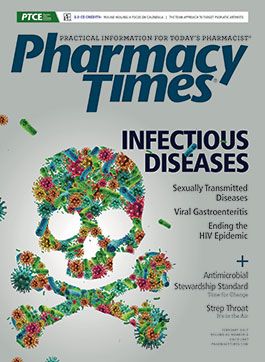Publication
Article
Pharmacy Times
How One Student Is Improving Patient Health and the Pharmacy Profession
Author(s):
Maria Gabriela Cabanilla, a student at the University of New Mexico College of Pharmacy, has demonstrated a passion for both helping those in need and advancing the pharmacy profession.

Maria Gabriela Cabanilla, a student at the University of New Mexico College of Pharmacy, has demonstrated a passion for both helping those in need and advancing the pharmacy profession.
Originally from Ecuador, Cabanilla has long been drawn to working with underserved communities. Prior to her admission to pharmacy school, she lent her bilingual skills to Catholic Charities, where served as an English as a Second Language tutor and helped adult students to prepare for the US naturalization exam.
When Cabanilla started pharmacy school, the 2017 PharmD candidate volunteered her time in health-focused efforts by coordinating health fairs, assisting with immunization clinics, and speaking to middle and high school students about the risks of opioid misuse. However, Cabanilla considers her most rewarding experience to be her participation with One Hope Clinic, where she helped to provide affordable health care to undocumented patients.
“The interprofessional aspect of the clinic offered lots of unique learning opportunities that continue to shape the way I conduct clinic visits,” Cabanilla told Pharmacy Times®. “It is extremely gratifying to help providers communicate with the patients while offering my own pharmacy input into their care, all in my own native tongue.”
Outside of her philanthropic endeavors, Cabanilla is a dedicated advocate for the pharmacy profession, having traveled to Washington, DC, to speak to senators and representatives about the evolving roles of pharmacists. Additionally, as policy vice president for her school’s chapter of the American Pharmacists Association Academy of Student Pharmacists, she worked with the offices of New Mexico Governor Susanna Martinez and Albuquerque Mayor Richard Berry to have October officially recognized as American Pharmacist Month.
She has also worked closely with one of her professors to research the use of nanotechnology in the aerosol delivery of drugs, and later presented her findings at the 2016 annual meeting of the American Association of Pharmaceutical Sciences.
“Pharmacy is a versatile career with abundant opportunities,” Cabanilla said. “I am enthusiastic about helping to shape the profession, and I look forward to exploring the ample prospects that a career in pharmacy has to offer.”
Q: What do you think is the most important quality for a pharmacist to possess?
A: It is well known that pharmacists will encounter obstacles in their careers, such as insurance not wanting to pay for a patient’s medication, a patient who doesn’t understand the importance of taking his/her medications, or providers who refuse to listen to our recommendations. Therefore, the most important quality for a pharmacist is perseverance. Pharmacists need to understand that we must continue to advocate for the health of our patients despite any difficulty that may stand in the way.
Q: What do you think is the most important issue in pharmacy? Why?
A: The most important issue is the effort to increase public awareness about the many roles of pharmacists. The misconception that pharmacists are confined to filling and dispensing medications continues to exist. Pharmacists are involved in many aspects of patient care that frequently go unnoticed, such as the analysis of potential drug—drug interactions, contraindications to therapy, over- and underdosing, therapy recommendations, and antimicrobial stewardship. Pharmacists also participate in many realms of health care, such as hospitals, primary and specialty care clinics, and health plans, to name a few. Pharmacists must continue the ongoing effort to promote awareness of our profession within our communities.
Q: Is there a specific patient or person you’ve worked with who taught you something that will help you be a better pharmacist?
A: During my HIV ambulatory care rotation, I had the pleasure of working with Michelle Iandiorio, MD. She has taught me the importance of always considering a patient’s social issues, how these affect their health, and how we can come up with a solution as a team. For example, a patient who is on antiretroviral therapy (ART) for HIV treatment should commit to 95% adherence prior to beginning ART. However, issues that have nothing to do with the medications may affect a patient’s ability to accomplish this. I have learned it is my responsibility to inquire about all aspects of a patient’s life to ensure we have exhausted every possibility to help the patient achieve his or her health goals.
About the School
The University of New Mexico College of Pharmacy offers a traditional PharmD program and a dual-degree program that enables students to also pursue an MBA. Students interested in clinical and research experience can also apply to one of the school’s residency or fellowship programs.
About RESPy
The RESPy (Respect, Excellence, and Service in Pharmacy) Award is presented to the student who has made a difference in his or her community by demonstrating excellence in pharmaceutical care. For more information, please visit PharmacyTimes.com.






